If you visit Milan, one of the top attractions after the Duomo and the Sforzesco Castle is Leonardo da Vinci’s masterpiece, The Last Supper.
While the mural is famous enough to attract countless visitors yearly, actually getting in to admire the masterpiece is no walk in the park.
As you might expect for a mural painting, The Last Supper couldn’t be moved to some prestigious museum, so it remains in its original place…
And that just so happens to be the dining room of an unassuming church that you would easily walk past without a second glance!
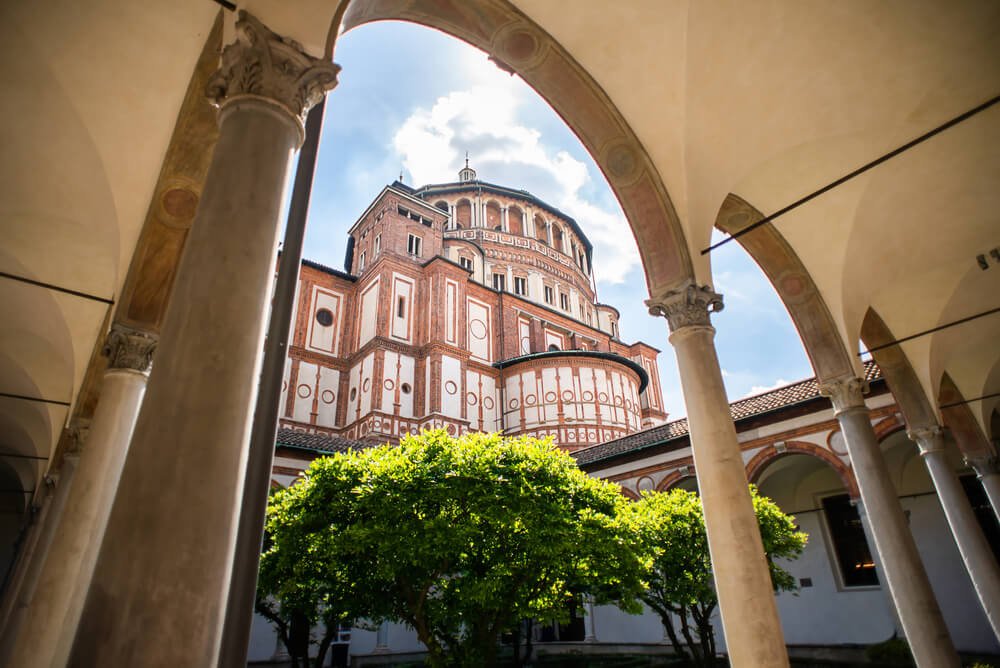
Even so, you can’t just show up at the door and pay to see the artwork.
You need a reservation, which you’ll probably have to make well in advance of your visit.
Read on to learn how to prepare for your visit to this impressive masterpiece, along with a few historical facts and tips to make the most of this once-in-a-lifetime experience.
Table of Contents
Brief History of the Dominican Convent of Santa Maria delle Grazie
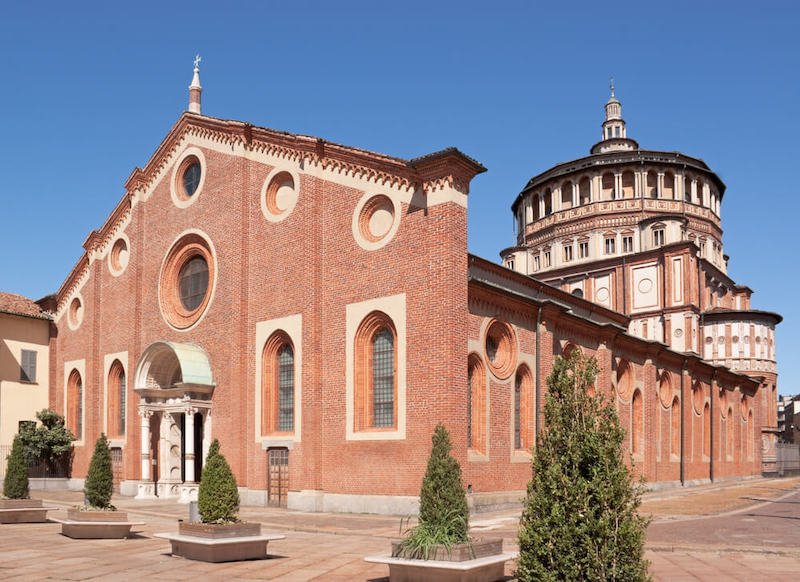
You may not know this from the photos, but this is a seriously massive painting!
The church and adjacent convent were built between 1463 and 1469 after Count Gaspare Vimercati (who was a troop commander for the Sforza family) gave the land to the Dominican priests of the Sant’Apollonia convent in Pavia.
The Last Supper covers an entire wall in the refectory of the church of Santa Maria delle Grazie.
Prior to construction of the church and convent, the site was home to a building housing the Vimercati troops, as well as a small chapel displaying a fresco of Our Lady of Graces, the Virgin Mary.
The fresco led the priests to dedicate the new church and convent to Our Lady of Graces, hence the name Santa Maria delle Grazie.
In 1492, the new Duke of Milan, Ludovico Sforza (known as Ludovico il Moro), decided to renovate the church and transform it into a family mausoleum.
As a part of the renovation, he commissioned Leonardo Da Vinci to paint The Last Supper in the church refectory.
In 1543, the church’s Chapel of the Holy Crown was adorned with an altarpiece by Titian, The Crowning with Thorns.

The painting was later taken to France thanks to Napoleon’s infamous practice of looting art during his military conquests, and it is now in the Louvre.
The church saw significant renovations during the 19th century, which included the reconstruction of the bell tower and the addition of a new cloister.
On the 15th of August, 1943, the church was significantly damaged during bombardment by Allied forces.
Most of the refectory was destroyed, but miraculously, the wall with The Last Supper survived due to prior reinforcement with sandbags.
After the war, the church was only partially rebuilt.
The Church and Dominican Convent of Santa Maria delle Grazie were declared UNESCO World Heritage Site in 1980.
In 1993, Pope John Paul II elevated the church to the rank of a minor basilica.
Brief History of Leonardo Da Vinci’s The Last Supper
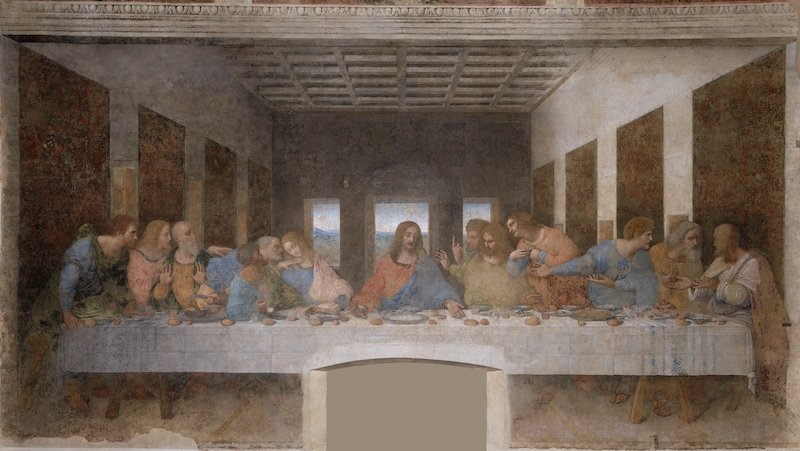
As mentioned above, Leonardo’s mural painting of The Last Supper is huge, covering an entire wall inside the refectory of the church of Santa Maria delle Grazie, now one of the biggest landmarks in Milan alongside the Duomo.
Following the commission of Ludovico il Moro, then Duke of Milan, Leonardo started working on The Last Supper in 1495 and only finished in 1498, although he did not work continuously.
(I mean, who among us hasn’t procrastinated on a big project?)
Leonardo opted for an experimental technique to create his masterpiece.
Instead of painting on wet plaster, as usual for frescoes at the time, he decided to apply a white preparatory layer to smoothen the wall and then used a dry technique.
As a result, the colors were not absorbed by the wet plaster. This experimental technique is the reason for the nearly immediate loss of pigment and decay of the fresco.
The reason for this unusual choice was Leonardo’s desire to work slowly and be able to make changes.
He wanted to infuse as many details as possible in his painting, and the classic fresco technique did not allow for many changes.
While the meticulous approach of the artist led to an undeniable masterpiece, it also came at quite a cost, condemning the artwork to a fast deterioration.
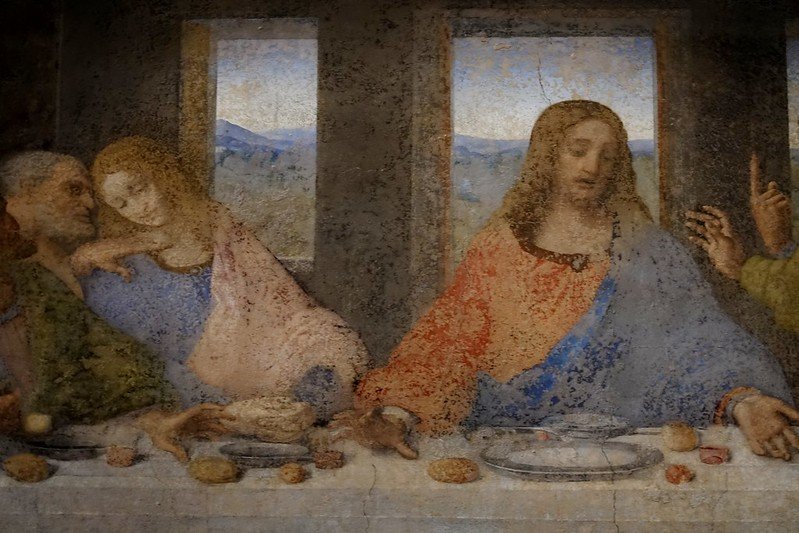
The first testimony of the decay of the painting dates to 1517, not even two decades after Leonardo finished the masterpiece.
Over the following decades, other artists observed that the paint was literally falling off the wall, and the fresco was just a faint shadow of the original work.
Early attempts to restore the fresco consisted of repainting entire portions of the artwork.
While they may have had some effect, the result was that little was left of the original work painted by Leonardo.
By the 20th century, restoration works had changed to an approach that focused on preserving the art piece and preventing further decay.
Between 1977 and 1999, a massive restoration work concentrated on recovering parts of the original painting by removing subsequent overpainting.
Though what remains is extremely faded and fragile, the fresco as you see it today is as close as possible to Leonardo’s original masterpiece.
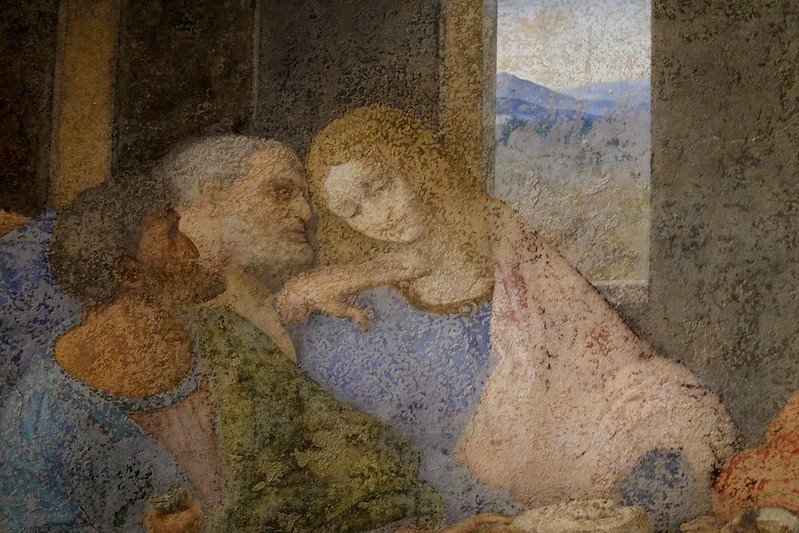
The scene depicts the famous moment from Scripture when Jesus told his Apostles that one of them was about to betray him.
In designing the work, Leonardo focused on the facial expressions of the Apostles upon receiving the surprising news.
Vivid portrayal of human emotions is one of the most distinctive features of Leonardo’s work, but in this painting, it reaches its absolute pinnacle of impressive representation.
According to a testimony of artist Giorgio Vasari from 1550, Leonardo “gave to the heads of the apostles great majesty and beauty, but left that of Christ imperfect, not thinking it possible to give that celestial divinity which is required for the representation of Christ.”
Years of close study of the painting led other artists and critics to identify many symbolic elements, like the spilled salt next to Judas, considered a bad omen, or Judas’ hand holding a purse of money, a reference to the thirty pieces of silver for which he betrays Jesus.

Leonardo’s masterpiece was an immediate inspiration to other artists who made copies of the fresco on various materials, from canvas paintings to mosaics and sculptures.
At first, artists created replicas because they feared for the integrity of the mural, which was already showing signs of decay.
Around the mid-16th century, an unknown artist painted a fresco in the church of Sant’Ambrogio in Ponte Capriasca, Switzerland.
Later, in 1612, The Last Supper was severely damaged, so Cardinal Federico Borromeo had a canvas copy made by Andrea Bianchi, known as Vespino.
The copy was placed in the Pinacoteca Ambrosiana, where you can still admire it when visiting today.
While some artists tried to reproduce Leonardo’s mural painting as faithfully as possible, others were inspired to create original works.
One such work is Andrea del Sarto’s 16th-century fresco inside the refectory of the church of San Salvi in Florence, now a museum.
Ticket Options to See The Last Supper
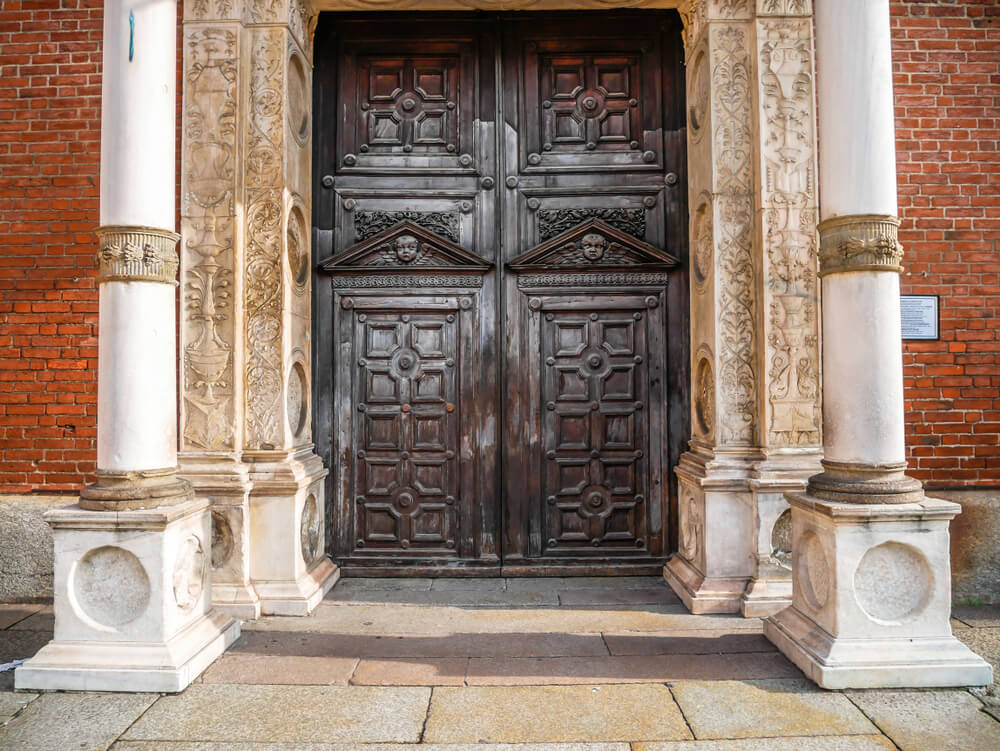
The cheapest option to see The Last Supper is to book your visit through the museum website.
Reservations open for every trimester, roughly one month before the start of the booking period.
For example, for the period between November and January, reservations open at the end of September.
If you visit Milan any time between June and September, keep your eyes on the calendar opening, as tickets sell out fast!
In the slow season, such as if visiting Milan in winter, you have a higher chance of finding tickets even just a couple of weeks before.
Consider yourself officially warned: do not expect to be able to book for the following day or even a few days ahead, regardless of the time of the year.
Such events are rare and purely up to chance.
If you’re not having any luck booking regular tickets in time, don’t worry! You have a few backup options left to try.
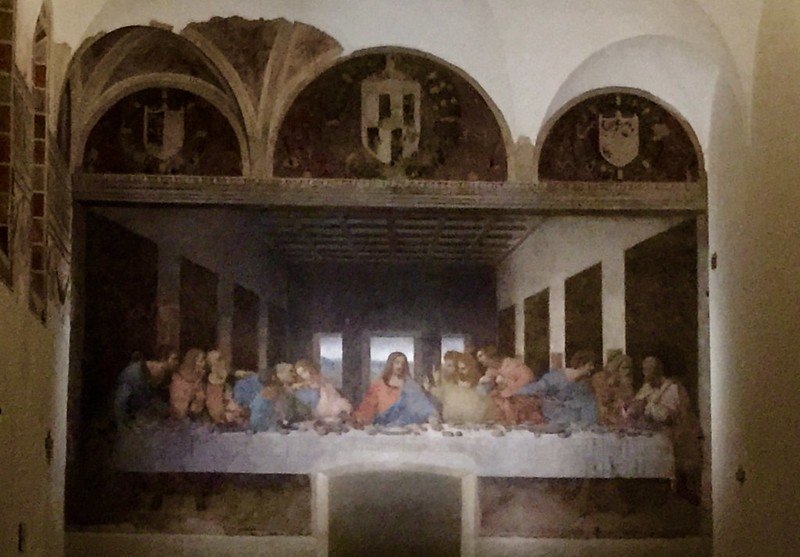
Organized guided tours usually have availability even if you book a few days before — great if you have an impromptu day in Milan like a layover that you’re planning last minute.
This Da Vinci’s Last Supper Guided Tour is one of the cheapest options, and it allows you to learn about the fascinating history of the mural painting from an expert guide. The tour lasts roughly an hour.
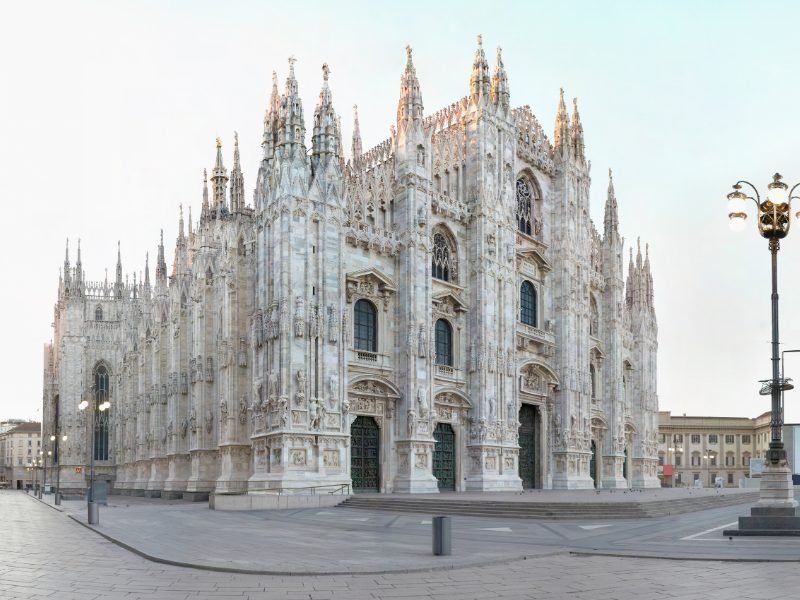
A great alternative that combines the visit to The Last Supper with a walking tour of Milan is this Historical Walking Tour and The Last Supper Ticket.
You’ll learn about Milan’s Renaissance history, pass by the Duomo, Teatro La Scala, and Sforza Castle, stroll through Galleria Vittorio Emanuele II, and check out Piazza dei Mercanti, the heart of Milan’s medieval heritage.
The tour lasts around three hours, including the 15-minute visit to The Last Supper.
Finally, another great option, though not available year-round, is this Milan In the Footsteps of Da Vinci 3-Hour Art Tour.
The tour explores the works of Leonardo Da Vinci in two locations, Santa Maria delle Grazie for The Last Supper and Pinacoteca Ambrosiana for the Atlantic Codex and Il Musico.
Along the way, your guide will tell you more about the life and genius of Leonardo Da Vinci.
Tips for Planning Your Visit to The Last Supper
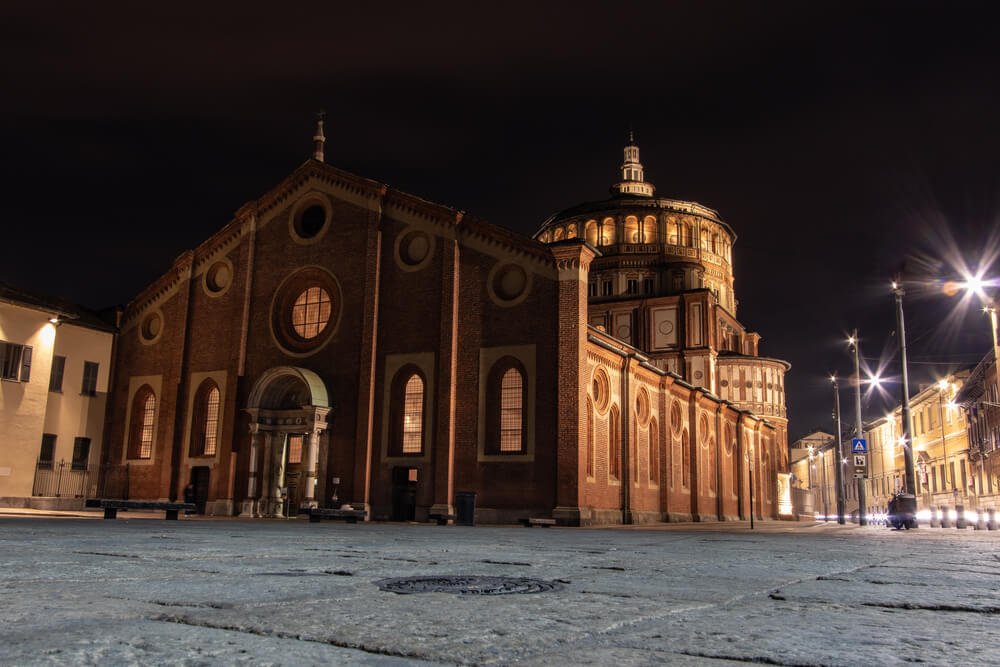
Currently, you can admire Leonardo’s masterpiece from Tuesday to Sunday, from 8:15 AM to 7 PM.
The museum is closed every Monday, as well as for New Year’s and Christmas Day.
Sometimes, you may find some out-of-the-ordinary opening times, so be sure to check the official website.
To be sure you’ll enjoy this world-famous masterpiece as much as possible, here are a few tips to prepare for your visit.
Reserve entry tickets well ahead of time!

I can’t emphasize this enough: book well in advance.
Access to The Last Supper is restricted to only a few visitors at a time, in turns of 15 minutes.
This means there is limited availability when it comes to tickets, and the only way to manage the high demand is by only allowing visitors who booked in advance.
If you don’t want to miss out on this attraction, you need to book your tickets ahead of time, and I mean up to three months before your visit, depending on the season.
Once you know your travel dates to Milan and start planning your Milan itinerary, booking a time slot for The Last Supper should be the very first thing you do.
Remember, you can book directly on the official website or get a guided tour.
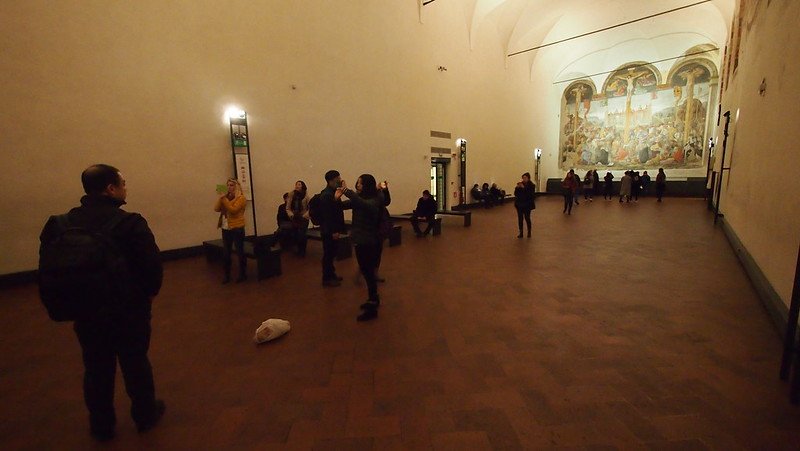
Organized guided tours usually have availability even if you book a few days before.
The cheapest option (and thus the guided tour that sells out the most quickly) is this one: Da Vinci’s Last Supper Guided Tour.
It’s cheaper because it’s only one hour long and is a tour of the church and Last Supper time slot only.
If that’s sold out, there’s also this Historical Walking Tour and The Last Supper Ticket.
It’s pricier because it also includes a walking tour of Milan, taking a total of 3 hours, only 15 minutes of which are dedicated to viewing The Last Supper.
Remember to pick up your tickets in person if needed.
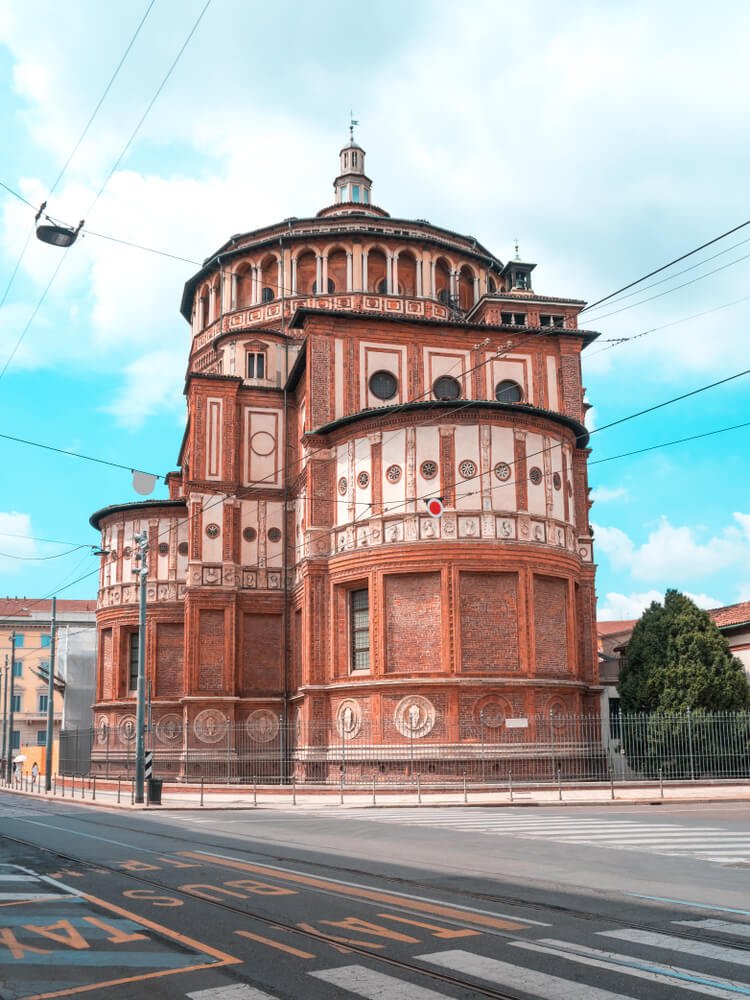
If you book an entry ticket on the museum’s website, don’t forget to pick up the tickets 30 minutes before your entry time.
You’ll have to go to the museum’s ticket office and show your ID to obtain your tickets.
This step is vital, as you can’t enter the museum just with the booking confirmation.
Furthermore, if you don’t show up roughly 30 minutes before the visit, you may lose your tickets and miss out entirely.
If you go with a guided tour, this step is not necessary as your guide will handle this part for you!
Tip: If you stay close to the area, this is even easier to do — the Navigli area is one of the best places to stay in Milan and is really close to the Last Supper!
Book a guided tour for more context.

If you are interested in learning more about Leonardo’s masterpiece and the convent of Santa Maria delle Grazie, consider getting a guided tour.
To be honest, the tour is one of the best ways to enjoy this classic work!
Even if you think it’s not worth it just for one work of art, you’ll be surprised to learn the many stories and hidden meanings behind the complex mural painting.
The guided tours are in Italian and English, with various time slots available from Tuesday to Sunday.
Be sure to note the schedules for the Italian and English tours to make sure you can book the correct one!
Leave big bags and backpacks in the cloakroom.

Visitors are not allowed to enter the room of The Last Supper with backpacks, suitcases, or any other big bag.
After picking up your tickets, you’ll be asked to leave your belongings in the coat check for the duration of your visit.
If you want to avoid leaving your luggage, leave it in the hotel or store it in one of the many storage places around the city.
Note that you can enter with a small bag or fanny pack.
Be mindful of the time you have for the visit.
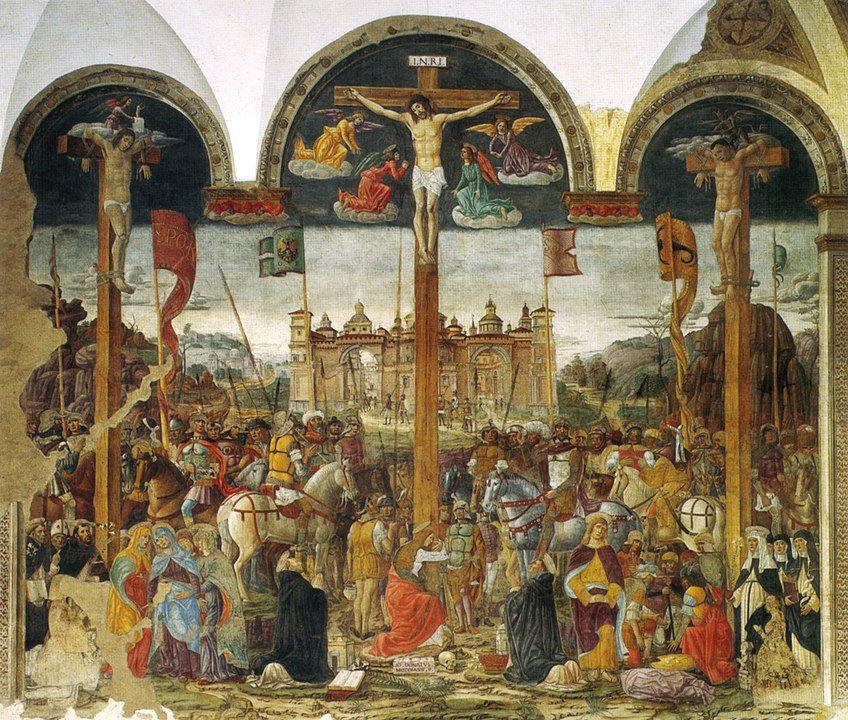
Remember that you only have 15 minutes to admire Leonardo’s impressive artwork.
However, there is only one other painting to distract you from the masterpiece, so you’ve got plenty of time to focus on the multitude of details.
Even so, don’t forget to check out also The Crucifixion by Donato Montorfano on the south wall.
The Crucifixion appears in much better shape than The Last Supper, given that it was painted with the classic fresco technique.
The most damaged parts are the additions that Leonardo made later, painting in Ludovico il Moro with his firstborn, Maximilian, and his wife, Beatrice d’Este, with their other son, Francesco.
After admiring the mural, you can learn more about its creation and many restorations in the Cenacolo Vinciano Museum. In total, the visit won’t take more than an hour.
Be aware of photography rules.
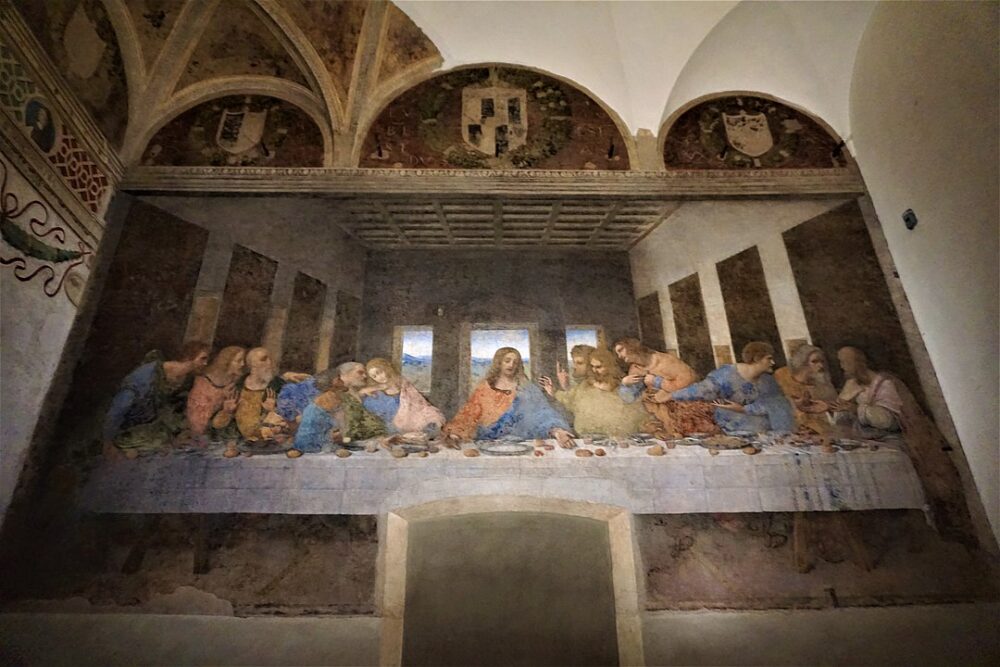
You can only take photographs of the painting without flash.
Camera flashes can damage the already fragile work of art, so they are strictly forbidden.
Furthermore, you are not allowed to take videos of The Last Supper.
Even if you could, the low light of the room and the feeble lights pointing at the mural make it nearly impossible to take a decent video, and remember: no tripods allowed!
Don’t skip the visit to the church of Santa Maria delle Grazie.

The room with The Last Supper is separate from the church, so you won’t necessarily have to enter it.
However, entry to the church is free of charge so, while you’re there, why not check it out?
The church interior is beautifully decorated with frescoes on the ceiling and in the multiple chapels.
One of the most noteworthy frescoes is the Crucifixion by Gaudenzio Ferrari, inside the Santa Corona Chapel.
When planning your trip to the church, you can be a little more flexible with timing, since it’s open to visitors at any time except during mass service.

Roxana is a Romanian-born freelance travel writer who has lived in Italy for over 15 years. She has a Master’s in Journalism and a Bachelor’s in Film Studies, and she studied at Università degli Studi di Roma Tre. Besides her native Romania, Roxana has lived in Rome, Lisbon, and Berlin, and she has traveled through much of Europe in search of hidden gems, history, and culture.